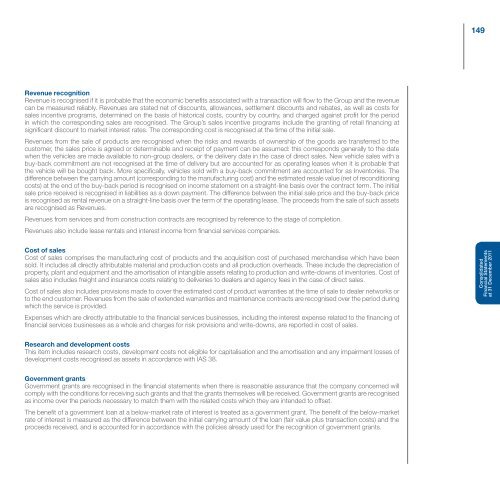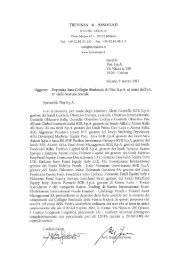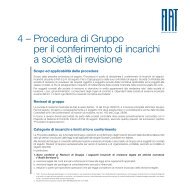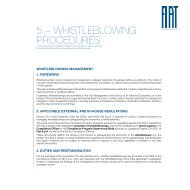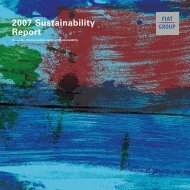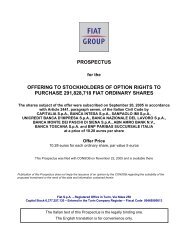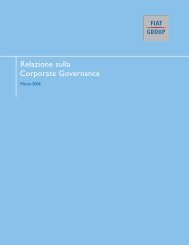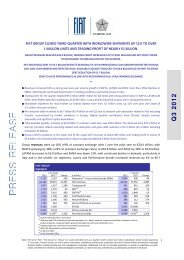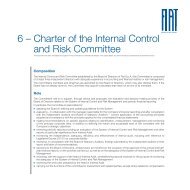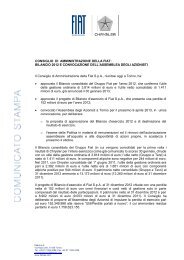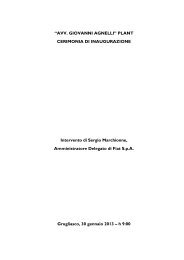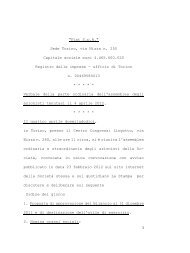Fiat Group - Consolidated Financial Statements and Notes - Fiat SpA
Fiat Group - Consolidated Financial Statements and Notes - Fiat SpA
Fiat Group - Consolidated Financial Statements and Notes - Fiat SpA
You also want an ePaper? Increase the reach of your titles
YUMPU automatically turns print PDFs into web optimized ePapers that Google loves.
Revenue recognition<br />
Revenue is recognised if it is probable that the economic benefits associated with a transaction will flow to the <strong>Group</strong> <strong>and</strong> the revenue<br />
can be measured reliably. Revenues are stated net of discounts, allowances, settlement discounts <strong>and</strong> rebates, as well as costs for<br />
sales incentive programs, determined on the basis of historical costs, country by country, <strong>and</strong> charged against profit for the period<br />
in which the corresponding sales are recognised. The <strong>Group</strong>’s sales incentive programs include the granting of retail financing at<br />
significant discount to market interest rates. The corresponding cost is recognised at the time of the initial sale.<br />
Revenues from the sale of products are recognised when the risks <strong>and</strong> rewards of ownership of the goods are transferred to the<br />
customer, the sales price is agreed or determinable <strong>and</strong> receipt of payment can be assumed: this corresponds generally to the date<br />
when the vehicles are made available to non-group dealers, or the delivery date in the case of direct sales. New vehicle sales with a<br />
buy-back commitment are not recognised at the time of delivery but are accounted for as operating leases when it is probable that<br />
the vehicle will be bought back. More specifically, vehicles sold with a buy-back commitment are accounted for as Inventories. The<br />
difference between the carrying amount (corresponding to the manufacturing cost) <strong>and</strong> the estimated resale value (net of reconditioning<br />
costs) at the end of the buy-back period is recognised on income statement on a straight-line basis over the contract term. The initial<br />
sale price received is recognised in liabilities as a down payment. The difference between the initial sale price <strong>and</strong> the buy-back price<br />
is recognised as rental revenue on a straight-line basis over the term of the operating lease. The proceeds from the sale of such assets<br />
are recognised as Revenues.<br />
Revenues from services <strong>and</strong> from construction contracts are recognised by reference to the stage of completion.<br />
Revenues also include lease rentals <strong>and</strong> interest income from financial services companies.<br />
Cost of sales<br />
Cost of sales comprises the manufacturing cost of products <strong>and</strong> the acquisition cost of purchased merch<strong>and</strong>ise which have been<br />
sold. It includes all directly attributable material <strong>and</strong> production costs <strong>and</strong> all production overheads. These include the depreciation of<br />
property, plant <strong>and</strong> equipment <strong>and</strong> the amortisation of intangible assets relating to production <strong>and</strong> write-downs of inventories. Cost of<br />
sales also includes freight <strong>and</strong> insurance costs relating to deliveries to dealers <strong>and</strong> agency fees in the case of direct sales.<br />
Cost of sales also includes provisions made to cover the estimated cost of product warranties at the time of sale to dealer networks or<br />
to the end customer. Revenues from the sale of extended warranties <strong>and</strong> maintenance contracts are recognised over the period during<br />
which the service is provided.<br />
Expenses which are directly attributable to the financial services businesses, including the interest expense related to the financing of<br />
financial services businesses as a whole <strong>and</strong> charges for risk provisions <strong>and</strong> write-downs, are reported in cost of sales.<br />
Research <strong>and</strong> development costs<br />
This item includes research costs, development costs not eligible for capitalisation <strong>and</strong> the amortisation <strong>and</strong> any impairment losses of<br />
development costs recognised as assets in accordance with IAS 38.<br />
Government grants<br />
Government grants are recognised in the financial statements when there is reasonable assurance that the company concerned will<br />
comply with the conditions for receiving such grants <strong>and</strong> that the grants themselves will be received. Government grants are recognised<br />
as income over the periods necessary to match them with the related costs which they are intended to offset.<br />
The benefit of a government loan at a below-market rate of interest is treated as a government grant. The benefit of the below-market<br />
rate of interest is measured as the difference between the initial carrying amount of the loan (fair value plus transaction costs) <strong>and</strong> the<br />
proceeds received, <strong>and</strong> is accounted for in accordance with the policies already used for the recognition of government grants.<br />
149<br />
<strong>Consolidated</strong><br />
<strong>Financial</strong> <strong>Statements</strong><br />
at 31 December 2011


